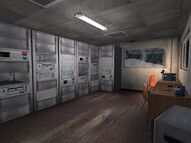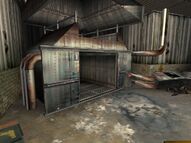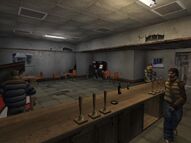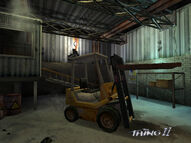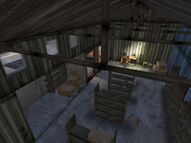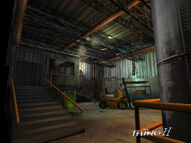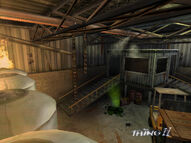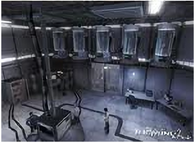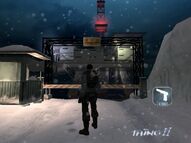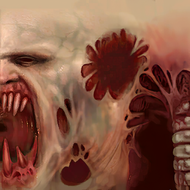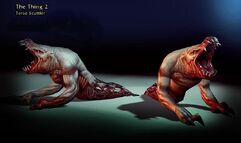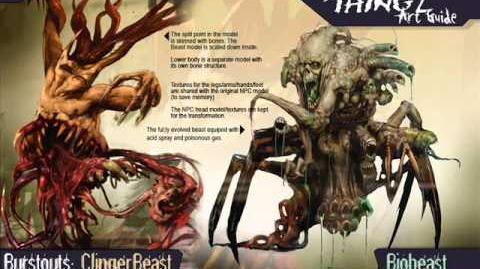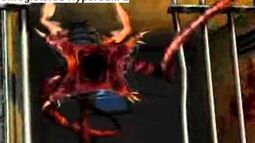The Thing II was a planned third-person survival horror game, and sequel to the 2002 video game The Thing. It was under development by Computer Artworks in 2003. However, it was ultimately cancelled after Computer Artworks entered receivership in October 2003[1]. In the plot the thing get onto an ice breaker vessel with Capt Blake in hot pursuit. Although cancelled, pre-production art guides and two creature video clips were released, revealing the developers' vision for the game.
Background[]
According to the Computer Artworks' pre-production concept art guide, the game was intended to follow the plight of protagonists Blake and MacReady, as they fought through a small snowy refinery town (presumably located in Antarctica), an oil rig and on-board an aircraft carrier. New types of Thing beasts were to be included in the game, which were intended to be deadlier and more elaborate than those from the first game. A new 'burst-out' system was planned for inclusion, which would have seen a variety of elaborate enemies burst out from infected non-player characters (NPCs). The geometry for the creature's reveal was intended to be hidden away inside the NPC model and would unfold as the monster is revealed. Technically-demanding, the 'burst-out' enemies would have been less frequently encountered than the simpler 'scuttler' creatures which lacked complex transformations. Burst-out creatures were also planned to progress through various stages of development—from a less threatening 'stage one' Thing to a fully-evolved state with multiple attack methods.
Interview with the developers[]
The developers of the original The Thing video game had this to say about the sequel in an interview:
"We had the contract in place to make the sequel and were pretty excited about it. We had a very cool prototype of 'dynamic infection' and some really imaginative thing 'burst-outs'. I particularly liked the one where the person would split in half and their top half would jump to the ceiling and start swinging around like an orangutan with his intestines turned into tentacles!" he grins. So it sounds like the sequel would have been awesome—what happened? "It was heart-breaking when Computer Artworks closed but it was a familiar story unfortunately," says Curtis gloomily. "We just grew too quickly, taking on a lot of projects including The Thing 2 and an Alone In The Dark sequel." Sadly, The Thing 2 never progressed much past a proof of concept demo that focused on the team's determination to solve the scripted infection issue.
Speculation[]
Although The Thing II never made it past proof-of-concept stage, certain elements can be inferred from the material provided. Others, however, can also be speculated, especially when contrasted against the first game:
- The plot of the game would have revolved around the plight of Blake and MacReady as they fought to defeat an infection in a refinery town and its surroundings. It is however unknown what could have led to the infection spiraling out of control, as Whitley was thoroughly defeated in the first game, with his plans for worldwide infection being derailed. Perhaps Gen Inc succeeded in contaminating the town with one of Whitley's planes, or personnel or Thing test subjects escaped and made it far across the snow, as in the 1982 film with the escaped Husky.
- It is unknown whether players would have been able to switch between Blake and MacReady as playable characters, or if MacReady would have been another NPC ally.
- Judging by one of the wallpapers, the game would have featured female characters, as opposed to the first game.
- Judging by one of the screenshots showing who appears to be Blake in winter camouflage, the game would have featured once more a Beretta 92 pistol in its arsenal.
- The item and weapons HUD would have carried over from the original, judging by the screenshot mentioned above.
- There would have been a prison-like area, according to one of the wallpapers, which shows prison cells with beds.
- It is unknown if the cold-exposure mechanic from the previous game would have been carried over, or changed in some way.
- The levels would have apparently been much larger, with more efficient loading times and strategies to compensate for the size.
- With the first game being heavily linear in its gameplay, it is unknown if the levels in the sequel would have featured more free-roam mechanics, encouraging exploration in non-linear ways to complete objectives (judging by the sheer size of the levels, which included entire refinery towns, aircraft carriers and oil rigs).
- Due to the sheer size of the levels, it is possible that vehicles could be commandeered by the player. The first game featured at least a helicopter level, although limited to on-rails shooting. A Sikorsky SH-3 Sea King helicopter is visible in the Aircraft Carrier Rupture image.
- According to the developers (and judging by some of the images) the graphics engine would have allowed for better effects and animations, such as special shaders, complex model geometry, specular lighting, multipass texturing, bump mapping, gloss, translucency and throbbing effects.
- The infection system criticized in the previous game was at the top of the priorities for the team, so it would have perhaps been far superior, allowing for random, non-scripted infections on any NPC, making the blood-test kits more useful and precious as a result, and succeeding in creating a more tense and frightening atmosphere.
- Squadmates could possibly mistrust each other and not just the player, generating a more tense and paranoid atmosphere, introducing a volatile mechanic to keep the player more on edge when managing the squad.
- One of the original plans by the development team for the first game was to have the player get every possible NPC that could be saved right to the end of the game, an ambitious plan which was scrapped early on in development. Perhaps, this mechanic could have been attempted in the sequel.
- Although the game features many Thing monsters, it is unknown if uninfected human enemies would have been present like in the first game.
- Deception would have played a much more prominent game mechanic in the sequel: one of the Assimilants is a grotesque semi-transformed human wearing a hooded winter coat which exposes its bare, wounded torso. This particular enemy would have been used to confuse the player; although viewed up-close from the front would quickly reveal the ruse, looking at it from the back, or in a heavy blizzard with poor lighting conditions at a distance, the player would inevitably assume it was a friendly human NPC, running to recruit it and encountering a hostile Thing instead. Even more dangerous, these monsters would have been able to carry firearms.
- Ruptures would have been much larger and dangerous than those from the first game: one virtually takes over an entire aircraft carrier.
- According to the developers, some of the larger Thing Beasts, like the Clinger Beast, would have featured one-hit-kill attacks, such as decapitations. The Clinger Beast would have lifted its victims from the ground right into its jaws. Other Thing Beasts, like the Bio-Beast and Sonic Beast, had devastating melee, gaseous, acidic and sound weaponry at their disposal, capable of both damaging and impairing the player, making one-hit-kills more likely. According to the developers, the Sonic Beast's jaw attack would have resulted in decapitations.
Images[]
Video[]
Trivia[]
- The Thing 2 Art Guide's front page utilizes unused cover artwork from the Dark Horse comic-book series The Thing from Another World.
- An area from the original The Thing 2002 video game is re-utilized in The Thing 2; it's the Strata Maintenance storage area with a forklift. It appears in two screenshots and the Quad Burstout Thing wallpaper. The area appears to have been reworked for the Quad Burstout Thing wallpaper, with added objects and better textures and lighting effects.
- The Thing 2 would have included female characters: there is a female corpse in the Quad Burstout Thing wallpaper. Much like in the 1982 film, the original 2002 game had notably no female characters at all, except for a computer voice (the Chess Wizard computer in the John Carpenter 1982 film, and the Gen Inc computer voice in the 2002 game, provided by actress Kat Cressida), The Howard Hawk's 1951 film and the 2011 prequel, on the other hand, included prominent female characters, as did the comic books. The story that spawned the franchise, Who Goes There? by John W. Campbell, didn't include any female characters.
- Since the premise of the game would have included Captain Blake teaming up with R.J. MacReady, it can be assumed to be canon that MacReady was never infected in the first game (it was left up somewhat up for interpretation, since Childs was shown to have died from exposure to the cold).
References[]
- ↑ Rob Fahey (23rd October 2003). Computer Artworks goes into receivership (English). GamesIndustry. Retrieved on 2015-06-28.
| |||||||||||

